Ecology is the study of interrelationships of organisms with each other and the environment. It deals with the distributions of populations and communities in space and time caused by biotic and abiotic interactions.
The Hierarchy of Life
1. Biosphere: it is the Earth. It contains all the ecosystems (életközösségek)
2. Biomes: these are defined by geographical zones and climate
3. Ecosystems (életközösségek): these are communities and their physical environments, so the associations of biotic and abiotic factors, linked through the flow of energy and the cycling of materials
4. Communities (társulások): populations of all species that live in one area
5. Populations: individuals of a species that live in the same area, interbreed with one another
6. Individuals (egyedek): single organisms of a given species
1. Biosphere
This is the whole planet.
Attempts have been made to create artificial biospheres, most successfully Biosphere 2 in the desert outside Tuscon, Arizona. It now belongs to the University of Arizona, although the initial lock-in experiments were carried out by a research company. Constructed between 1987 and 1991, it explored the web of interactions withing life systems in a structure containing 5 biome-based areas, an agricultural area and human living and working spaces. It also explored the use of closed biospheres for space colonization and allowed the study and manipulation of a biosphere without harming the Earth's (source: Wikipedia). The first mission ran for 2 years (the humans were locked in), while the second only lasted 6 months (due to company management problems)
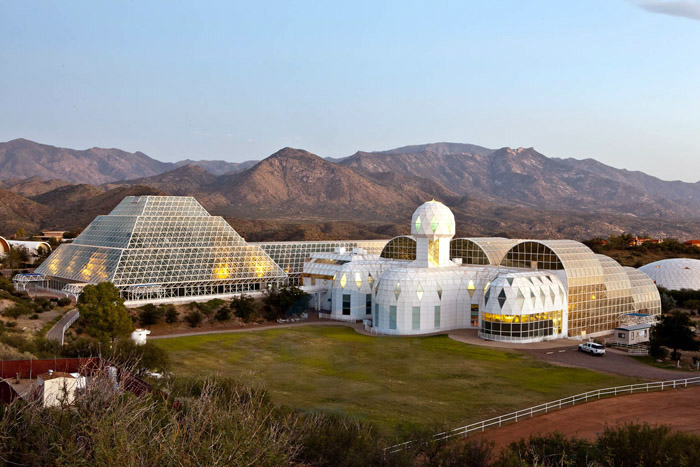 |
| Biosphere 2 (source: Wikipedia) |
 |
| http://archive.bio.ed.ac.uk/jdeacon/biosphere/biosph.htm |
 |
| http://discovermagazine.com/2010/oct/20-life-under-the-bubble |
 |
| http://www.tripadvisor.com/LocationPhotoDirectLink-g31296-d108684-i77149467-Biosphere_2-Oracle_Arizona.html |
A theory that is related to the biosphere is called the
Gaia theory. It was created in 1970 by James Lovelock and later co-developed with Lynn Margulis (she also came up with the endosymbiotic theory). It remains quite criticized, but is nonetheless an interesting idea. It states that organisms interact with their inorganic surroundings to form a self-regulating complex system that contributes to maintaining the conditions for life on the planet. Topics of interest include how the biosphere and the evolution of life forms affect the stability of global temperature, ocean salinity, oxygen in the atmosphere and other environmental variables that affect the habitability of Earth.
2. Biomes
Biomes are defined by their geographic locations and climate (especially precipition and temperature, but also light, soil, nutrient availability and oxygen). In general biodiversity (the number and variety of species) is highest in the tropical biomes and lowest in the arctic biomes. The following map shows a general distribution of terrestrial biomes on the planet.
 |
| http://www2.brevard.edu/pfi/BiologicalDiversity1.htm |
The combination of temperature and precipitation define where certain biomes will exist.
 |
| http://www.learner.org/courses/envsci/unit/text.php?unit=4&secNum=2 |
 |
| http://en.wikipedia.org/wiki/Biome |
Some of the major biomes are the following:
a) Tropical rainforest: 2000-5000mm precipitation/yr, average temperature 25C, fast rates of decay and nutrient uptake, poor soil, plants include giant trees with shallow roots and many types of lianas and epiphytes.
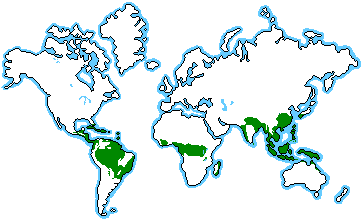 |
| http://www.blueplanetbiomes.org/rainforest.htm |
 |
| http://room42.wikispaces.com/Rainforest+Geography |
b) Tropical seasonal (monsoon) forest: these forests experience a wet and a dry season, trees grow to about 40m, there are more shrubs and fewer epiphytes than in the rainforest
 |
| http://www.marietta.edu/~biol/biomes/tropdry.htm |
 |
| http://mobile.ztopics.com/Monsoon%20forest/ |
c) Savanna: also experience wet and dry seasons, greater daily temperature change than in the forests and soil is more fertile. Both woody and grassy savannas exist. Generally good agricultural land.
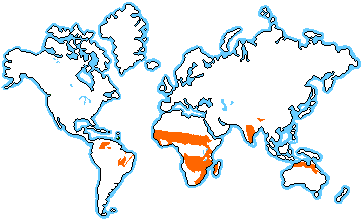 |
| http://www.blueplanetbiomes.org/savanna.htm |
 |
| http://bioexpedition.com/savanna-biome/ |
d) Desert: less than 250mm precipiation/year, large temperature variation, both sandy and rocky deserts can be found, little vegetation, primarily succulents and ephemerals
 |
| http://scienceray.com/biology/ecology/plants-and-animals-adaptations-to-the-desert-biome/ |
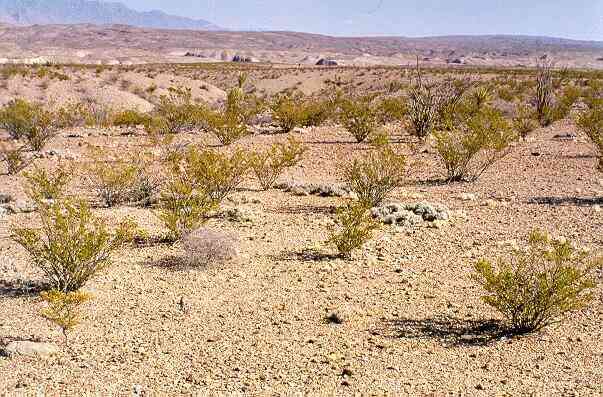 |
| http://archive.bio.ed.ac.uk/jdeacon/desbiome/biome.htm |
 |
| http://www.glogster.com/cknguyen/the-desert-biome/g-6lrs72d0n7n0f4vp288sga0 |
e) Temperate grasslands: experience 4 seasons, 200-500mm precipitation/yr, lots of humus, rich soil
 |
| http://www.roebuckclasses.com/105/physical/biomes/grassland/tempgrassland.htm |
 |
| http://prezi.com/pb0dy3lrxzgc/temperate-grasslands/ |
f) Deciduous (lombhullató) forest: more than 500mm precipitation/yr, have 4 seasons with min. 5-6 month growing season, extent of undergrowth depends on how closed the canopy is, richer animal life than in the grasslands
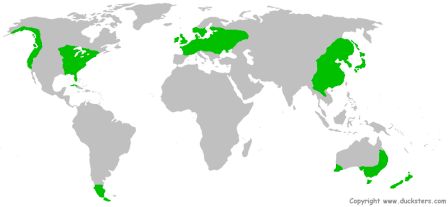 |
| http://www.ducksters.com/science/ecosystems/temperate_forest_biome.php |
 |
| http://www.bio.miami.edu/dana/dox/biomes.html |
g) Taiga (Boreal forest): long, cold winters and cool, short summers, low levels of precipitation which falls primarily as snow, soil is thin and acidic, slow rates of decomposition, swamps and fens are commonly found in this biome
 |
| http://claremontgeography12.blogspot.hu/2011/05/tundra-biome.html |
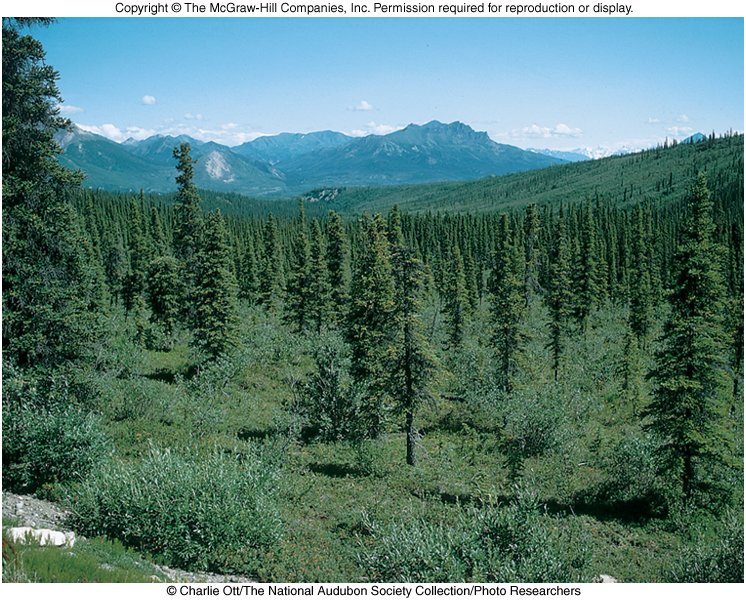 |
| http://www.bio.utexas.edu/faculty/sjasper/Bio301M/biomes.html |
h) Tundra: cold, very low precipitation, dwarf forests and grassy tundra (sedges, mosses and lichens), much of the animal life are seasonal summer migrants
 |
| http://shawn-miller.weebly.com/ |
 |
| http://laurentmikhail.hubpages.com/hub/Tundra-Biome |
 |
| http://www.earthonlinemedia.com/ebooks/tpe_3e/biomes/biomes_tundra.html |
i) Polar ice: phototrophs are only algae, life depends on surrounding oceans, ground is permanently frozen
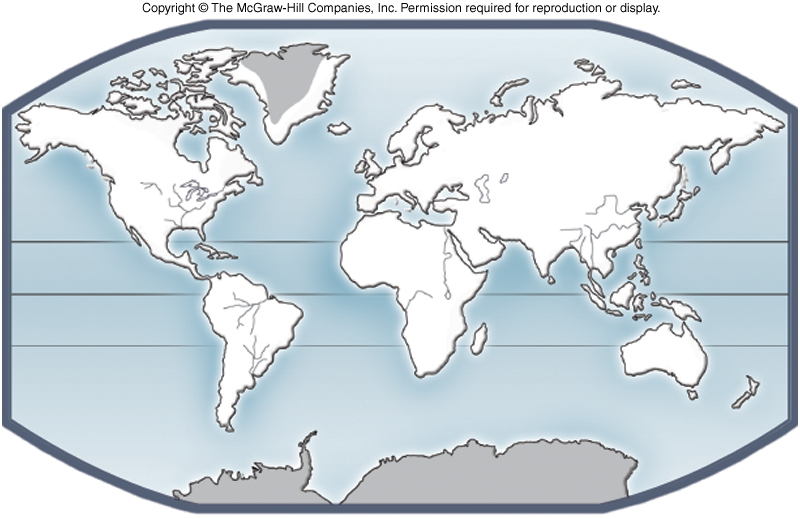 |
| http://www.zo.utexas.edu/faculty/sjasper/images/f37.34b.jpg |
j) Mountains (Alpine): exhibit vertical zonality in which altitude acts similarly to latitude. Also gradient and aspect (eg. northern vs. southern exposure) affects light, precipitation (eg. rainshadow) and other abiotic factors
 |
| http://uanews.org/story/rain-gods-in-a-desert-sea-new-book-celebrates-southern-arizona-s-mountains |
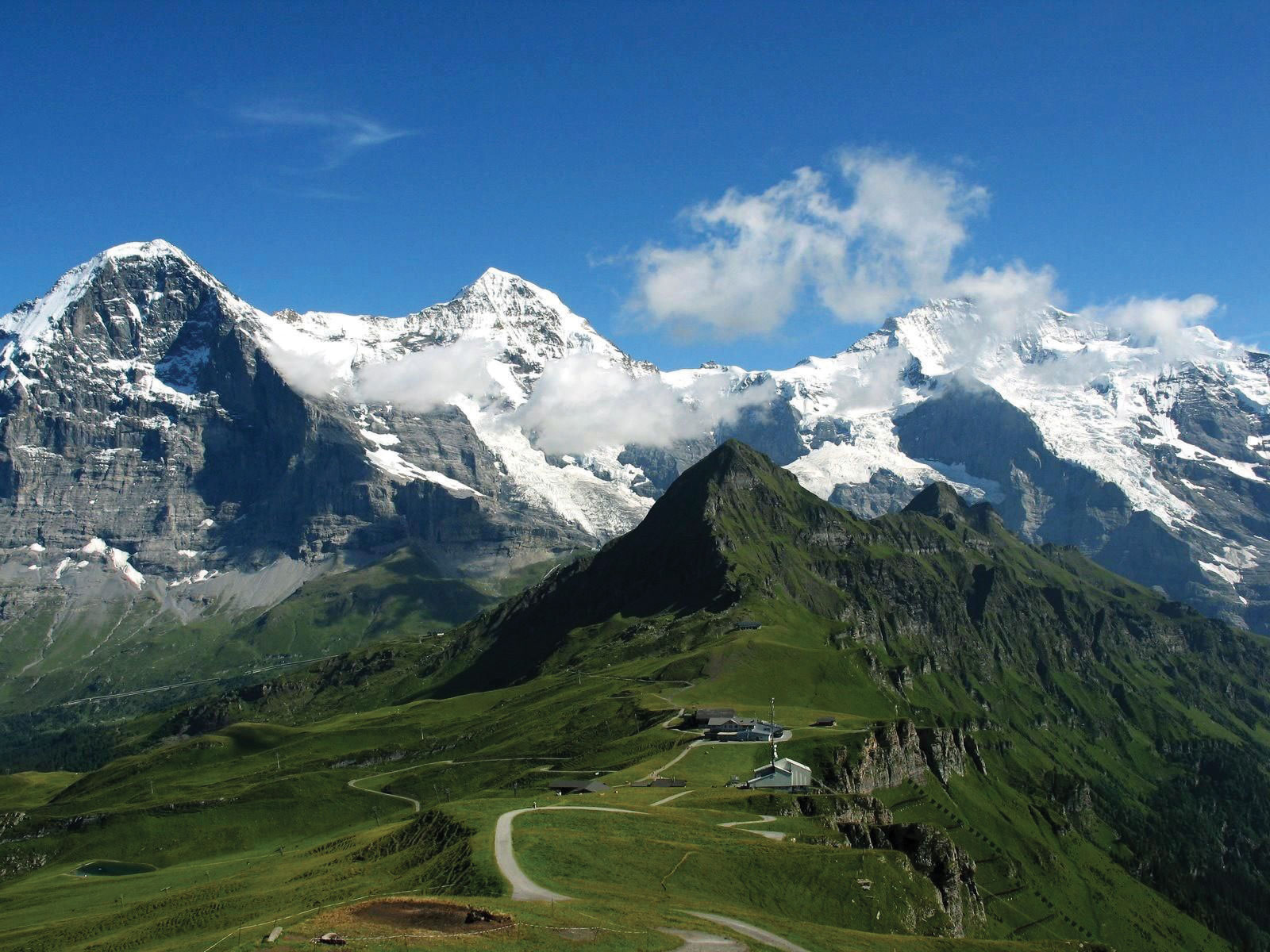 |
| http://prezi.com/_luflm2zbbcb/the-alpine-biome/ |
k) Marine (about 71% of the Earth's surface): exhibits both horizontal (following major geographic zones - tropical, temperate, artic) and vertical (light decreases with depth) zonality. Light is available in the euphotic zone, but below about 400m, no light penetrates through the water column, creating an aphotic zone. Temperature variation in the marine environment is minimal in any given location and worldwide only ranges between about 2C-30C. Nutrient availability is a determining factor for live in this biome. Nutrient-rich waters are found near the shores, where nutrients enter from rivers, streams and run-off. Upwellings (feláramlások) are also areas of high nutrients. Organisms in this biome can be classified as benthic (bottom-dwellers), nektonic (swimmers) or planktonic (floaters). Three major zones exist:
 |
| http://earthsciencetopics.wikispaces.com/13 |
littoral (tengerparti): includes the intertidal and the area found above the continental shelf (about 200m deep). It is an area of rich life and high biodiversity with both plants (monocots) and algae supporting a wide range and number of consumers.
 |
| http://www.glogster.com/jconway429/intertidal-zone/g-6mfcd9jg6qdsahtrimu1oa0 |
pelagic (nyíltvízí): the top 200m of water beyond the continental shelf, lower biodiversity, colder water. Life in this zone is based on plankton (especially phytoplankton, which is more abundant in colder waters than in the tropics)
 |
| http://tracc-borneo.org/pom-pom-island-biodiversity/pelagic-fish-schools/ |
abyssal (mélytengeri): darkness prevails here, along with high pressure, low temperatures, low nutrients (most fall from above). Most living organisms in this zone are predators, scavengers and decomposers.
 |
| http://www.artinaid.com/2013/04/the-ocean-layers/ |
Thermal vents are an exception to some of the above limits.
 |
| http://www.wildmusic.org/soundmap/sounds/blacksmoker |
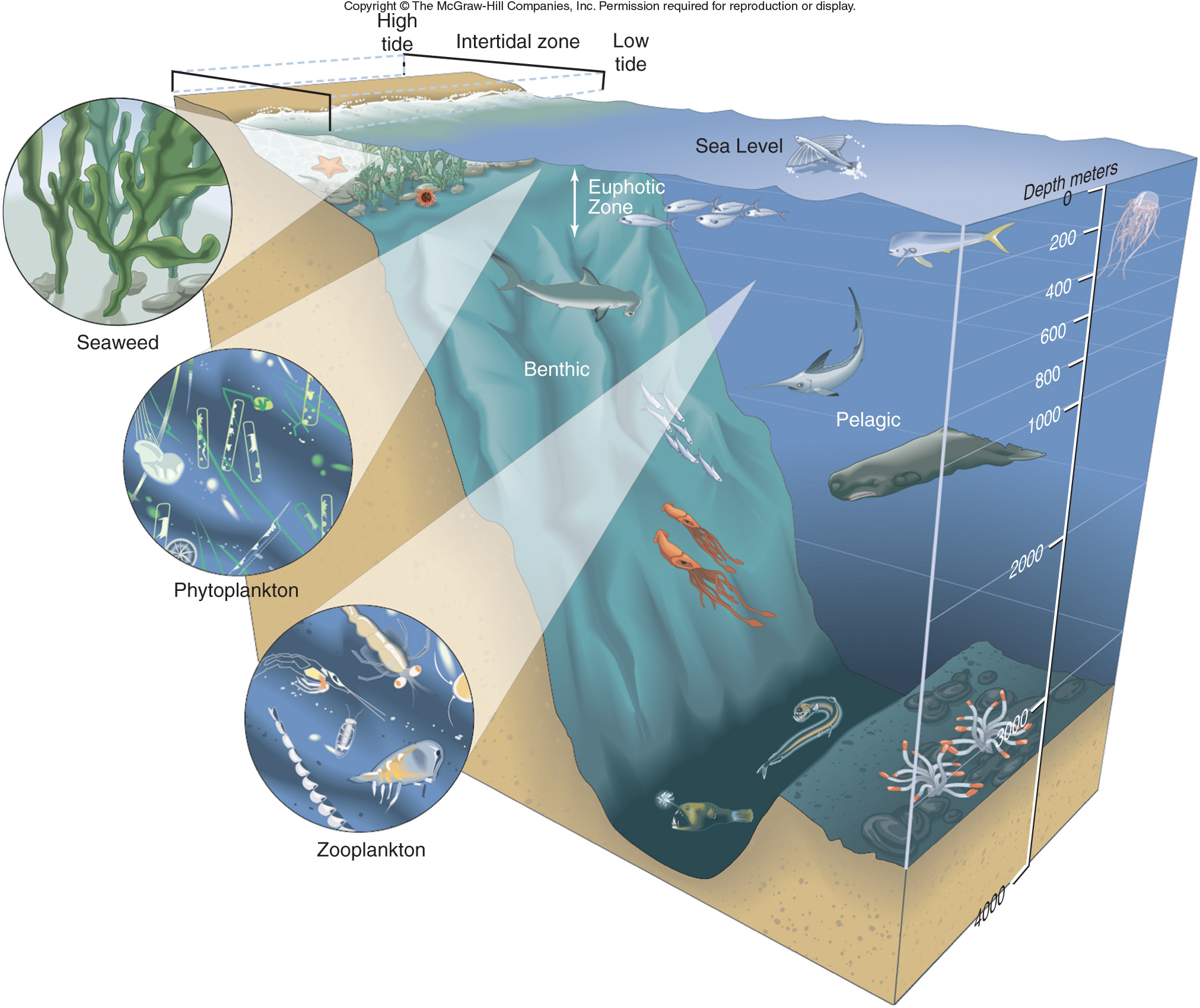 |
| http://www.bio.utexas.edu/faculty/sjasper/Bio301M/aquahab.html |
 |
| http://www.learner.org/courses/envsci/visual/img_lrg/aquatic_biomes.jpg |
l) Freshwater: degree of diversity depends upon the surrounding geographical zone. Includes lakes, ponds, streams and rivers. Zones in lakes include: littoral - where plants can grow on the bottom because there is sufficient light, limnetic - open water within the euphotic zone, profundal - the aphotic zone
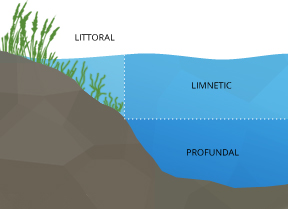 |
| http://www.fondriest.com/environmental-measurements/parameters/weather/photosynthetically-active-radiation/ |



































No comments:
Post a Comment